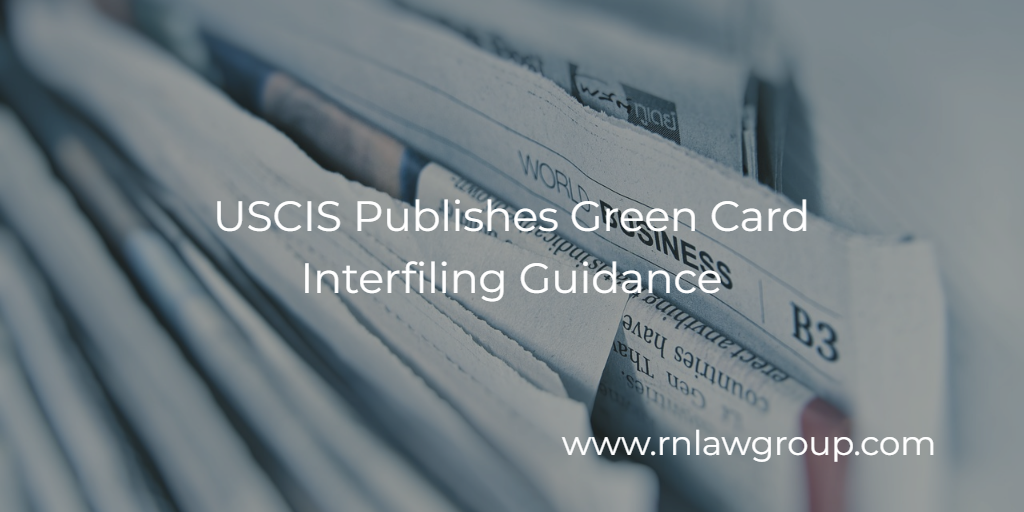
USCIS Publishes Green Card Interfiling Guidance
On Friday January 21, 2022, USCIS issued formal guidance regarding “Transfers of Underlying Basis”, more commonly known as Green Card interfilings. A “Transfer of Underlying Basis” or “interfiling” is based on a pending I-485 Green Card petition. For purposes of our discussion a “Transfer of Underlying Basis” is a request to transfer your employment-based green card from one employment-based immigrant category to another, different employment-based immigrant category while remaining with the same company (“employment-based sponsor”).
For instance, let’s assume you have two I-140s approvals (one EB-2 and one EB-3) from Company A. Your priority date was current under EB-3 so you filed your Green Card based on that EB-3 I-140 approval. Now, you’ve begun seeing that EB-2 dates are more advantageous than EB-3. You can request USCIS to “transfer the underlying basis” of your pending I-485 from its originally filed EB-3 category to the “more preferred” EB-2 category. By leveraging the “Transfer of Underlying Basis” interfiling mechanism, USCIS will then consider your I-485 under the EB-2 preference category rather than the originally filed EB-3 preference category.
To be eligible for a “Transfer of Underlying Basis”, you must 1) continually maintain your eligibility for the underlying/original classification requested, 2) your I-485 must remain pending, 3) you must be eligible for the substituted classification requested, and 4) your priority date is current under that substituted classification requested. USCIS does not charge a fee for this request.
To continually maintain your eligibility for the underlying/original classification requested, this does not mean per se that you must be continually maintaining non-immigrant status or that you must be maintaining a non-immigrant visa to take advantage of a transfer of underlying basis. Instead, our focus should be placed on the underlying/supporting I-140 itself—has it been withdrawn, revoked? Have you attempted an I-485 Supplement J portability of the job offer to another employer? If so, it is likely that you have not maintained eligibility for the underlying/original classification requested. In essence, if the I-140 supporting the original filing of your I-485 remains “healthy”, you should not have concerns about maintaining that eligibility of the underlying/original classification requested.
To be eligible for the substituted classification requested is typically a formality. In the above scenario, EB-2 and EB-3 I-140s are already approved through Company A. Because we have the approvals in hand, we can generally assume eligibility for the substituted classification requested.
Interfiling requests are typically straight-forward requests. However, one of the larger concerns inherent in requesting an interfiling is that USCIS does not give receipts for such requests. In USCIS’ new guidance, they implicitly suggest that filing an I-485J from the sponsoring company to confirm the job offer is the sole means available to obtain any documentation from USCIS that an interfiling request has been made and/or accepted.
For instance, I have a pending EB-3 I-485 with an approved EB-2, both from the same company. I can request an interfiling from USCIS by sending a letter in the mail. USCIS will not give a receipt notice. Instead, I request an interfiling from USCIS at the same time I submit an I-485J from the company confirming the EB-2 job offer remains open. USCIS will give a receipt notice. Thus, if you are interested in requesting a Transfer of Underlying Basis it is advisable to do so with a concurrent filing an I-485 Supplement J from the I-140 sponsoring company.
Finally, a request to Transfer of Underlying Basis cannot not guaranteed. USCIS will review your request to transfer the underlying basis of your pending Green Card case but does so at their discretion. If USCIS denies the request, nothing bad happens to your pending Green Card; it simply remains pending in its originally filed employment-based classification requested. Although USCIS appears friendly and open to transfers between the first three employment-based categories, approval of the Transfer of Underlying Basis is up to USCIS and there is generally no appeals of that decision. Other than the eligibility requirements detailed above, USCIS will consider the effects of additional processing time required to gather evidence to support the applicant’s new claim, the reason(s) for the request, the availability or unavailability of documentation to support the new claim, the degree of difficulty in obtaining needed receipt files from other USCIS offices; the degree of difficulty in determining the applicant’s continued eligibility from the first underlying petition or basis; and the extent of processing steps already taken on the adjustment application.
By Ryan A. Wilck, Partner and Attorney at Law
Ryan Wilck is an Attorney at Reddy Neumann Brown PC helping clients with the final phases of the permanent residence process. “Concilio et labore” is not only the motto of Ryan’s favorite sports club but is also his life motto; all things come through wisdom and effort. Ryan is passionate about gaining the trust of his clients by utilizing a relentless and detail-oriented work ethic to understand their specific goals and concerns, hoping to instill a sense of confidence and stability. Whatever your immigration problem, he and his team will find a solution, through wisdom and effort.

